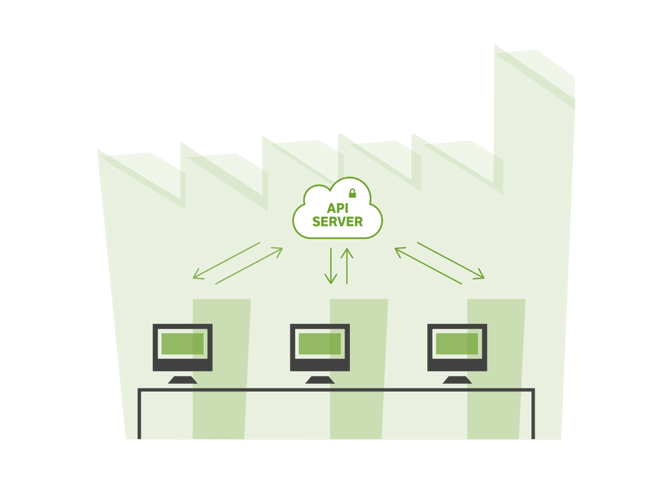An API-based solution has many advantages. The biggest one is the significant spare on development and maintenance costs, thanks to a modular infrastructure. With the example of a recent work for a watch manufacturer, this blog post explains you in 4 points what added value an API can bring to your IT environment.
Context: a manufacturer's production line without a central server
We were recently involved in the digital transformation of a manufacturer's production line. The main issue of this manufacturer was control-desktops that were not centrally managed. In consequence, for each code change, an update was required on each control-desktop. It was an expensive and time-consuming process.

This image represents a production line with standalone control-desktops, and their costly maintenance routines.
We evaluated the potential and feasibility of centralizing the core processes into one single central server. This server codebase would be accessible via an API by the decentralized control-desktops.
The proposed architecture was a web-based solution. This means that each remote unit would access the main server via its web browser (i.e. Google Chrome, Firefox, Internet Explorer, etc.), as you would access any website.
Your advantages with an API-based solution
1/ Up-to-date information at any time
Linking your server and a web application with an API allows you to control information at any time. In other words, one code deployment on the centralized server updates each control-desktop automatically, because each machine accesses the software via the web browser.
As a result, the data managed in a single location is always up-to-date, and is available through an API to all consuming devices.
2/ Faster and more flexible deployments
A central server contains all the codebase. Each control-desktops interacts with the central server. Thus, deploying a new control-desktop is a breeze! There is no more software to setup on each new device: just plug and play.
3/ Development time reduced — investment lowered
Operating System versions of the production line have less and less importance thanks to the generalization of web-based softwares. Going through the web browser allows to bypass historical technical constraints such as software and version compatibility, and it's especially relevant since Microsoft ended its support for old Internet Explorer versions which were often a source of abnormal bugs.
This means that you do not need to find an “old-technology specialist” anymore. As a consequence, development and maintenance investments get reduced.
4/ Security increased
With an API-based infrastructure, process execution happens on one single machine (i.e. the server) instead of X error prone control-desktops. Therefore, this prevents the risk to have old code on the machines, or operating systems not updated to the latest version.
You may wonder if the data transmission security isn't compromised then? This questioning isn't relevant anymore: using tools such as HTTPS/SSL encryption or private networks make this argument invalid.
To conclude – an easier step to digital transformation

This image represents a production line with a central API server that allows to have always-up-to-date control-desktops' web application.
As explained in this blog post, taking the leap to an efficient and evolutive infrastructure is easier if your software solution is build around APIs. Indeed, an API-based solution will lower your development and maintenance costs, while it will increases your software security.
At Liip, this is how we see industries properly embracing a digital transformation to keep up with their competitors.

